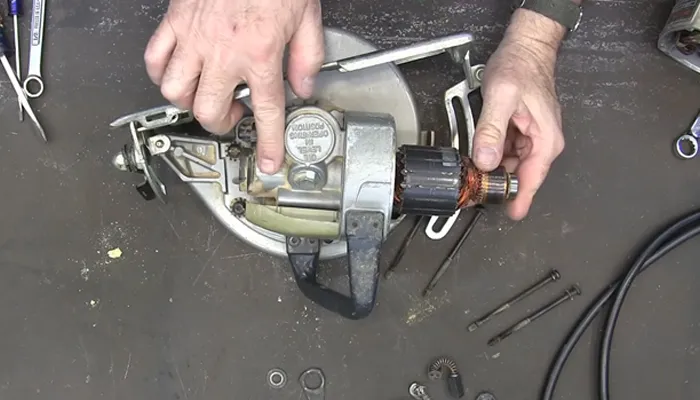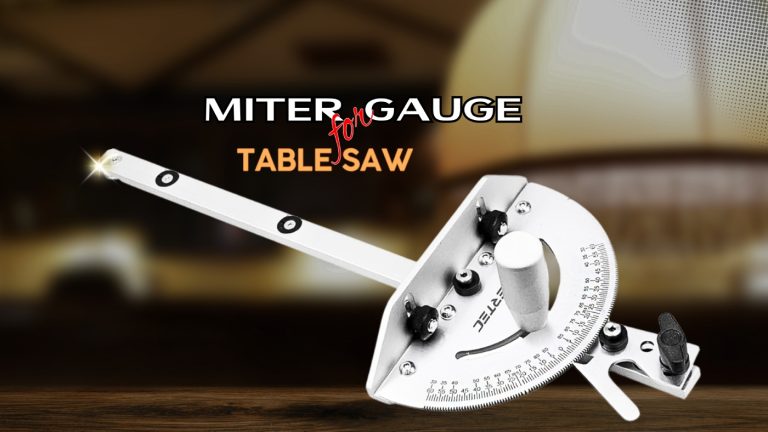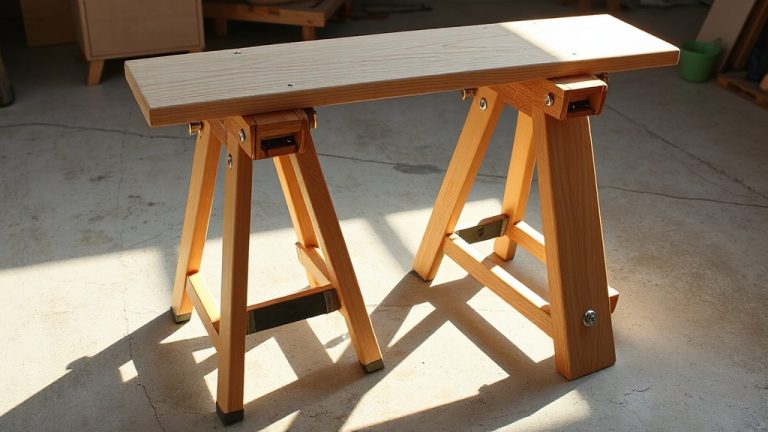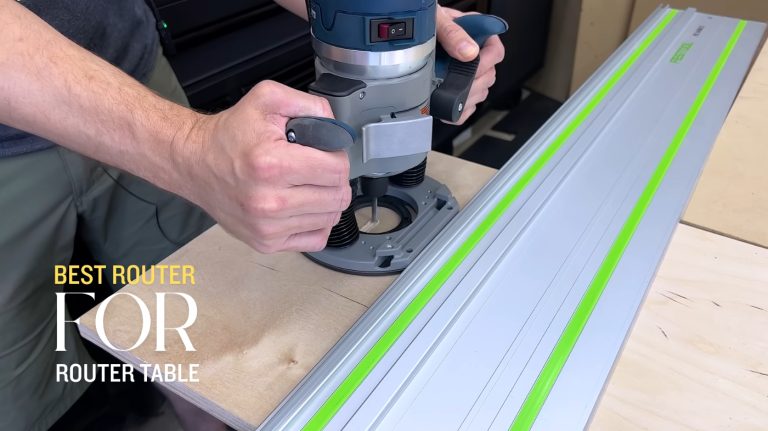How to Cut Melamine? Pro Tips for Chip-Free Results
To cut melamine cleanly, use a carbide-tipped blade with 80–100 fine teeth, preferably a triple-chip grind. Set the blade depth just below the panel thickness.
Place masking tape along the cut line and score the surface with a sharp knife to minimize chipping. Cut at a steady speed, supporting the sheet firmly and keeping the finished side down or inward.
Proper blade choice and technique make a big difference; deeper guidance will help you master each step efficiently.
Key Takeaways
- Use a fine-tooth carbide-tipped blade with 80-100 teeth and a triple-chip grind for clean melamine cuts.
- Position the finished side down, apply masking tape along the cut line, and score both sides before cutting.
- Maintain steady feed rates and appropriate saw RPM (3,000–4,500 for circular saws) to reduce chipping and tear-out.
- Support and clamp the melamine sheet securely on a flat surface with a sacrificial board underneath.
- Smooth cut edges with fine-grit sandpaper and apply iron-on edge banding for a professional finish.
Choosing the Right Blade for Melamine
When cutting melamine, choosing the right blade is essential to achieve smooth, chip-free edges and preserve the integrity of the material.
Opt for a high tooth count blade, between 80 and 100 teeth, with carbide-tipped teeth for durability and sharpness.
Look for a triple-chip grind (TCG) design, which alternates flat raker and trapezoidal teeth to reduce chipping.
Fine-tooth configurations with small gullets minimize tear-out.
Prefer blades specifically made for melamine or laminated surfaces over general-purpose ones.
Standard kerf blades often cut cleaner than thin kerf blades, balancing waste reduction and edge quality.
Ensure your blade size matches your saw’s arbor and panel thickness, commonly 7-1/4″, 10″, or 5-1/2″ diameters.
Balanced blades with heat expansion slots improve stability, reduce vibration, and maintain cutting accuracy during use. It is also important to make slow, steady passes during cutting to ensure clean edges and prevent splinters.
Additionally, selecting a blade with an appropriate RPM range helps optimize cutting speed and quality for melamine panels.
Preparing the Melamine Surface for Cutting
Before cutting melamine, you need to prepare its surface carefully to prevent chipping and guarantee a clean edge.
First, identify the finished side and position the board so this side faces inward toward the blade. This reduces visible chipping. When using saws that cut from below, place the finished side down.
Always position the finished side facing the blade or down when cutting to minimize visible chipping.
Next, apply wide masking tape along the cut line to protect the surface and avoid lifting. Score the melamine coating with a shallow cut about 1/16 inch deep using a knife or blade, following a guide for accuracy. Using masking tape along the cut line helps minimize chipping and surface damage.
Support the sheet on a flat surface, clamp it securely, and use a sacrificial board beneath to prevent tear-out. These steps stabilize the panel and protect the surface, ensuring cleaner, chip-free cuts.
Best Tools for Cutting Melamine Sheets
If you’re looking to cut melamine sheets cleanly, there are a few tools you should consider. For straight cuts, a circular saw is a great option. Always use blades specifically designed for laminate or melamine to ensure clean cuts and reduce chipping. Choosing blades with appropriate tooth size and spacing will further enhance cutting performance.
If you need to make curves, a jigsaw will do the trick nicely. And for those times when you want precision, a table saw is your best bet.
Now, when it comes to the blades, you definitely want to equip your saws with fine-tooth carbide-tipped blades. For circular saws, aim for blades with at least 36 teeth.
If you’re using a table saw, go for something with 80 teeth or more. This helps minimize chipping, which is super important for a clean edge.
Lastly, remember to maintain a steady and controlled cutting speed. This won’t only reduce tear-out but also help you achieve those smooth edges you’re after. Additionally, applying masking tape along the cut line before cutting can significantly prevent chipping on the surface.
Ideal Saw Types
Although melamine sheets can be challenging to cut cleanly, selecting the right saw and blade combination makes all the difference. You want a tool that balances precision with minimal chipping to maintain the sheet’s smooth surface.
Here are the ideal saw types to consider:
Table Saw: Best for straight, repetitive cuts on large panels; use a laminate-specific blade and ensure proper setup. It is crucial to use a high-quality, carbide-tipped blade with 80–100 teeth for the cleanest cuts.
Circular Saw: Versatile for various sizes; clamp a guide and score first to reduce chipping.
Plunge/Track Saw: Offers portability and precise, splinter-free cuts with adjustable plunge depth.
Jigsaw: Suitable for curved cuts but prone to chipping; use fine-tooth, down-cutting blades.
Hand Saw: Useful for small, quick cuts but less precise and slower than power tools.
Recommended Blade Features
When cutting melamine sheets, selecting a blade with the right features is crucial to achieving clean, chip-free edges.
Choose a high tooth count blade, 80 to 100 teeth, to minimize chipping. A 100-tooth blade on a 5-1/2″ saw offers ideal smoothness. Using a saw with the appropriate blade size ensures optimal cutting depth and control.
Look for carbide-tipped teeth, preferably double-hard C-4 submicron carbide, for durability and sharpness retention.
Blades featuring a 40° hook angle and double-faced tooth design reduce tear-out on both sides.
Opt for thicker blade plates to dampen vibration and maintain stability. Avoid thin kerf blades that may roughen edges. Many melamine blades include thick plates with copper plugs to further reduce vibration and ensure smoother operation.
Consider blades with resin coatings to prevent heat buildup and material adhesion.
Some blades incorporate scoring teeth or Hi-A/T geometry to pre-cut laminate, further enhancing edge quality.
Cutting Speed Settings
Since cutting melamine requires both precision and care, adjusting your cutting speed settings is essential to achieve clean edges and prolong bit life. You’ll want to balance RPM and feed rate carefully to avoid burning or chipping. Always ensure your workspace is stable and free of clutter to maintain safety while adjusting cutting speeds.
For example, 18,000 RPM works well with 3/8″ compression bits, but reducing to 15,000 RPM can extend bit life. Increasing feed rates helps dissipate heat and prevents premature bit wear.
Consider these key points when setting your speeds:
Use 13,500–18,000 RPM depending on bit type and coating. Aim for feed rates between 400 and 1,104 ipm based on bit and thickness. Cut full 3/4″ melamine in one or two passes to reduce wear. It is also important to use a 1/2 inch down spiral bit for all dado cuts to ensure efficient material processing.
Higher feed rates reduce heat buildup, extending bit lifespan. Adjust settings as bits dull to maintain edge quality and efficiency. Additionally, wearing safety goggles and gloves is recommended to protect yourself during the cutting process.
Cutting Techniques to Reduce Chipping
To reduce chipping while cutting melamine, you need to combine careful blade selection, precise tape application, and controlled cutting techniques.
Start by applying masking tape along the cut lines on the good face, positioning it inward toward the blade to protect the surface and minimize tear-out.
Apply masking tape on the good face along cut lines, placing it inward to protect and prevent tear-out.
Next, make shallow scoring cuts on both surfaces before the full cut to pre-cut the laminate layer and reduce edge chipping. It is important to score both sides of the melamine before making the through cut to ensure a clean edge.
Use a high-tooth-count carbide blade with a triple-chip grind, setting blade height just above the melamine thickness to lessen stress on edges.
Secure the panel firmly, support longer boards to prevent flexing, and feed the material steadily with gentle pressure.
Optimal Saw Speed and Settings
When you’re cutting melamine, it’s best to set your saw’s RPM between 3,000 and 5,000. This range helps ensure clean cuts.
And don’t forget to position the blade guard properly—it’s there to protect both the blade and yourself! Always make sure the blade guard is functional before starting your cut.
Now, let’s talk about the feed rate. You want to control it carefully; if you go too fast, you might end up with chipping.
On the flip side, if you go too slow, you risk getting burn marks. The key is to maintain a consistent speed and apply steady pressure.
Maintaining the recommended tooth surface speed ensures optimal cut quality and blade performance.
Ideal RPM Range
Although the ideal RPM for cutting melamine depends on your blade diameter and material thickness, maintaining speeds between 3000 and 4500 RPM is best for typical circular saw blades.
This range balances peripheral speed and cut quality, minimizing chipping and prolonging tool life. For smaller blades, expect to increase RPM to maintain cutting efficiency.
Keep in mind:
- Match RPM to blade diameter for consistent peripheral speed (60-80 m/s).
- Use higher RPM with slower feed rates to reduce edge chipping.
- Compression bits in CNC setups perform well around 18,000 RPM.
- Blades with high tooth counts (e.g., 96 teeth) tolerate higher RPM without quality loss.
- Adjust RPM based on material thickness and machinery capabilities for ideal results.
Additionally, selecting high-quality, professional-grade saw blades designed specifically for melamine ensures cleaner cuts and less chipping.
Blade Guard Positioning
How should you position the blade guard to balance safety and cut quality when working with melamine?
Expose only the minimum blade necessary—typically about half the tooth height—before making a skim or scoring cut.
If scoring, you may partially retract the guard but never remove it unless absolutely necessary.
Always restore it before the full-depth cut.
Clamp a straightedge to guide the saw, positioning the guard so it doesn’t interfere with the track yet covers as much blade as possible.
For table saws, adjust the overhead guard vertically.
For track saws, ensure the retractable guard aligns with material orientation.
Always inspect the guard for damage and maintain its function to prevent binding.
Never bypass or permanently disable the guard; it protects you and helps maintain a clean, chip-free cut.
Using a sharp blade is essential to complement proper guard positioning for optimal cutting performance on melamine.
Choosing a blade with a higher tooth count can significantly improve cut smoothness and reduce chipping when working with delicate materials like melamine.
Feed Rate Control
When cutting melamine, controlling your feed rate and saw speed is crucial to achieving clean edges and extending tool life. Choosing the right saw motor type can also influence the cut quality and noise levels.
Ideal saw speeds range from 3,000 to 4,500 RPM for saw blades, while CNC routers operate between 12,000 and 20,000 RPM depending on bit size. Balancing feed rate and speed helps prevent burning, chipping, and premature tool wear.
Set spindle speed around 16,000 RPM for 1/2″ compression bits to maximize tool life. Adjust feed rate between 850 and 2,000 ipm, reducing 20-40% for smaller bits. Maintaining a steady chip load is essential for prolonging tool life and ensuring smooth cuts. Maintain steady feed pressure to avoid edge chipping and material burning.
Use slower feed with higher RPM for thicker or full-thickness cuts. Fine-tune speeds and feeds based on bit size, cut depth, and melamine thickness to match the belt drive system capabilities for optimal performance.
Using Tape and Scoring Methods
Why risk chipping the melamine surface when you can prevent it with simple tape and scoring techniques? Start by applying high-quality masking tape directly over the cut line. Score through the tape with a sharp utility knife to create a shallow groove about 1/16 inch deep.
This groove guides your saw blade, reducing splintering and tear-out. For best results, ensure you use a sharp utility knife to make the scoring precise and clean. Regular maintenance of your cutting tools, including blade cleaning, can also help achieve smoother cuts and protect delicate surfaces.
| Step | Purpose |
|---|---|
| Apply masking tape | Protect surface, mark cut line |
| Score cut line | Create clean guide groove |
| Saw with fine blade | Execute smooth, chip-free cut |
Score both sides if possible, especially on thicker pieces. Use consistent feed and support the board well. This method ensures precise, clean cuts while safeguarding melamine’s delicate surface by minimizing vibration and noise that can cause surface damage.
Handling and Finishing Cut Edges
After making clean cuts using tape and scoring methods, the next step is to handle and finish the exposed edges to protect and enhance your melamine project.
Start by smoothing edges with fine-grit sandpaper, sanding upward to prevent tearing the coating. Using a high tooth count blade can help achieve cleaner initial cuts, reducing the need for extensive sanding.
Next, apply iron-on edge banding with heat and pressure, trimming excess with a sharp tool for a flush finish. It is important to maintain the iron temperature around 350°F-375°F to activate the adhesive properly without damaging the melamine surface.
Use touch-up paint or fillers to cover any chips or imperfections.
For high-wear areas, consider solid wood edge banding or epoxy for added durability.
- Sand edges gently with 320-grit paper to smooth roughness.
- Apply iron-on edge banding, using an iron and roller for adhesion.
- Trim excess banding carefully with a blade or trimmer.
- Use touch-up paint pens to conceal minor chips.
- Employ fillers for larger edge repairs before sanding smooth.
Troubleshooting Common Cutting Issues
Although melamine offers a sleek finish, cutting it without causing chips can be challenging. Chipping often results from blade wobble, dull blades, or cutting too fast. Applying blue painter’s tape on the cut line is a proven method to minimize chipping and tear out during cutting. Regularly checking the bandsaw fence alignment can also help ensure clean, precise cuts.
To troubleshoot, ensure your blade is sharp, melamine-specific, and properly mounted. Use moderate feed rates and consider painter’s tape on cut lines. Equipment maintenance is critical; check spindle runout and clean collars regularly.
| Issue | Common Cause | Solution |
|---|---|---|
| Surface chipping | Thin melamine layer | Use scoring blade or tape |
| Blade wobble | Bent spindle or worn bearings | Inspect and replace parts |
| Edge tearing | Dull blade | Replace with carbide-tipped |
| Excessive chipping | High feed rate | Slow down feed speed |
| Misaligned cuts | No straight reference | Use track saw or fence |
Tips for Cutting Holes and Openings in Melamine
When cutting holes and openings in melamine, you’ll want to prioritize controlling chipping and ensuring clean edges by carefully preparing the workpiece and selecting the right tools.
First, identify the good side and face it into the blade or drill to protect the visible surface. Use tape or a chip guard to minimize tear-out.
Secure the board firmly to prevent slipping. Start with a pilot hole for accuracy and drill halfway before flipping the board to finish from the other side, reducing blowout.
Choose carbide-tipped blades or hole saws designed for laminates, and adjust blade depth to just below material thickness for cleaner cuts.
- Mark precise hole locations with pilot holes
- Use tape or chip guards on cut lines
- Secure melamine firmly with clamps
- Drill halfway, then flip board to finish
- Opt for carbide-tipped drill bits and blades
Additionally, applying masking or painter’s tape along the cut line helps hold the surface and prevents chipping by stabilizing the thin, brittle outer layer of melamine, which is prone to damage when cut improperly outer layer protection.
Frequently Asked Questions
Can I Cut Melamine With a Standard Wood Blade Safely?
You can cut melamine with a standard wood blade, but it’s not ideal and requires extra caution. Expect more chipping and potential kickback due to the blade’s aggressive teeth.
Keep the blade sharp, cut slowly, and secure the workpiece firmly. Score the surface first and cut with the good side down to minimize damage.
For safer, cleaner cuts, though, consider using a fine-toothed carbide blade designed for melamine.
How Do Temperature and Humidity Affect Melamine Cutting Quality?
Temperature and humidity directly impact your melamine cutting quality.
High heat softens adhesives, risking delamination and warping, while excess moisture causes swelling and edge degradation.
Fluctuating conditions increase internal stress, leading to chipping and uneven cuts.
To guarantee clean cuts, keep temperature below 85°C and maintain stable humidity levels.
Properly cured panels resist these effects better, so always store and cut melamine in controlled environments for best results.
Is It Necessary to Wear a Mask When Cutting Melamine?
Yes, you should wear a mask when cutting melamine.
The process generates fine dust containing resin and formaldehyde, which can irritate your respiratory system.
Using an N95 or higher-rated respirator guarantees you avoid inhaling harmful particles.
Combine this with proper ventilation and dust extraction for the best protection.
Don’t rely on disposable dust masks alone; they offer minimal defense.
Protecting your lungs is critical during every cutting session.
What Is the Best Way to Dispose of Melamine Dust and Scraps?
You should know that melamine dust is combustible, so disposing of it safely is vital.
Collect dust and scraps using non-sparking tools, then seal them in proper containers to prevent dispersal.
Avoid burning or flushing them down drains. Instead, use licensed waste contractors or approved landfill and incineration facilities.
Recycling is best if available.
Always follow local regulations, and keep waste sealed and stored away from heat or ignition sources to minimize risks.
Can Melamine Sheets Be Bent After Cutting Without Cracking?
You can bend melamine sheets after cutting, but only with mild curves to avoid cracking.
To improve flexibility, gently heat the sheet to soften the resin surface. Using thinner sheets or those with MDF cores helps since they resist cracking better.
Score-cutting the back side creates controlled flex points. Always support the bend with a form to maintain a consistent radius.
Avoid sharp or forced bends, as they’ll likely cause fractures.
Perfect Your Technique for Cleaner, Sharper Edges
Cutting melamine doesn’t have to be a delicate dance. Armed with the right blade, tools, and techniques, you’ll breeze through it like a pro.
Remember, prepping your surface and using tape or scoring methods can spare you from those pesky chips. Keep your saw speed steady, handle edges carefully, and troubleshoot as needed to avoid unwelcome surprises. With these practical tips, your melamine cuts will look sharp and polished every time.







